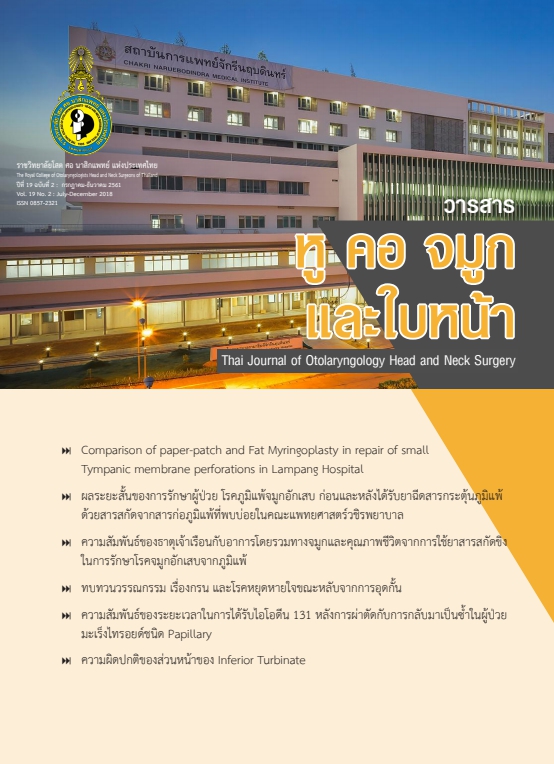ความผิดปกติของส่วนหน้าของ Inferior Turbinate
Main Article Content
Abstract
บทคัดย่อ
จากการสังเกตผู้ป่วยกลุ่มหนึ่งที่ได้รับการตรวจร่างกาย พบว่ามีความผิดปกติของส่วนหน้าของ inferior turbinate บางรายมีความสัมพันธ์กับโรคมะเร็งต่อมน้ำ เหลือง (NK-T cell lymphoma) การศึกษาวิจัยนี้จึงมุ่งเน้นศึกษาถึงเรื่อง ความผิดปกติของส่วนหน้าของ inferior turbinate ว่าสัมพันธ์กับภาวะทางคลินิกใดบ้าง และเพื่อสร้างความตระหนักถึงเรื่องเนื้องอกของ inferior turbinate เมื่อตรวจร่างกายพบผู้ป่วยที่มีลักษณะของส่วนหน้าของ inferior turbinate ที่ผิดปกติ เช่น เนื้อนูน หรือมีสีของเยื่อบุผิดปกติ แตกต่างจากสีเยื่อบุส่วนอื่นของ inferior turbinate
วัตถุประสงค์ในการวิจัย
เพื่อศึกษาถึงภาวะทางคลินิกที่สัมพันธ์กับความผิดปกติของส่วนหน้าของ inferior turbinate และเพื่อสร้างความตระหนักถึงเรื่องเนื้องอกของ inferior turbinate เมื่อตรวจร่างกายพบผู้ป่วยที่มีลักษณะของส่วนหน้าของ inferior turbinate ที่ผิดปกติ
วิธีการวิจัย
Observational descriptive study จัดทำ ที่แผนกตรวจผู้ป่วยนอก ภาควิชาโสต ศอ นาสิกวิทยา คณะแพทยศาสตร์โรงพยาบาลรามาธิบดี มหาวิทยาลัยมหิดล โดยมีผู้ป่วยเข้าร่วมงานวิจัยจำ นวน 19 คน
ผลการวิจัย
ผลทางพยาธิวิทยาของผู้ป่วยที่ตรวจพบความผิดปกติของส่วนหน้าของ inferior turbinate ประกอบด้วย
hemangioma, dense plasma cell infiltration, invasive adenocarcinoma, minor salivary gland with fibrosis,chronic inflammation และ chronic inflammation ร่วมกับลักษณะต่างๆ เช่น mucous gland hyperplasia, granulation tissue และ tissue eosinophilia ผู้ป่วยส่วนใหญ่พบลักษณะทางพยาธิวิทยาอยู่ในกลุ่มของ chronic inflammation จำ นวน 14 คน จาก 19 คน คิดเป็น 73.68% และพบว่าผู้ป่วยกลุ่มนี้มีแนวโน้มมีความสัมพันธ์กับโรคภูมิแพ้ และการใช้ยาพ่นจมูกสเตียรอยด์ แต่จากการศึกษานี้ไม่พบความสัมพันธ์อย่างมีนัยสำคัญทางสถิติ ผู้ป่วยส่วนน้อยพบลักษณะทางพยาธิวิทยาเป็นเนื้องอก และภาวะที่ต้องเฝ้าระวังเนื้องอก ได้แก่ hemangioma, invasive adenocarcinoma และ monoclonal gammopathy of undetermined significance (MGUS) จำนวน 3 คน จาก 19 คน คิดเป็น 15.79% นอกจากนี้พบผู้ป่วยที่ได้รับการรายงานผลทางพยาธิวิทยาเป็น minor salivary gland with fibrosis จำ นวน 2 คน จาก 19 คน คิดเป็น 10.53%
บทสรุป
ผู้ป่วยที่มีความผิดปกติของส่วนหน้าของ inferior turbinate ส่วนใหญ่อยู่ในกลุ่มของ chronic inflammation นอกจากนี้ยังพบผู้ป่วยที่มีลักษณะของเนื้องอก และภาวะที่ต้องเฝ้าระวังเนื้องอก ได้แก่ hemangioma, invasive adenocarcinoma และ monoclonal gammopathy of undetermined significance (MGUS) ดังนั้นโสต ศอ นาสิกแพทย์ ควรตระหนักถึงโอกาสที่จะเกิดเนื้องอกทั้งในกลุ่ม benign และ malignancy ในผู้ป่วยที่มีความผิดปกติ ของส่วนหน้าของ inferior turbinate ด้วย และเมื่อพบความผิดปกติ ได้แก่ รอยนูน และมีสีแตกต่างจากเนื้อ inferior turbinate ทางด้านหลัง ควรพิจารณาตัดชิ้นเนื้อส่งตรวจทางพยาธิวิทยา
Article Details
ต้นฉบับที่ส่งมาพิจารณายังวารสารหู คอ จมูก และใบหน้า จะต้องไม่อยู่ในการพิจารณาของวารสารอื่น ในขณะเดียวกันต้นฉบับที่จะส่งมาจะผ่านการอ่านโดยผู้ทรงคุณวุฒิ หากมีการวิจารณ์หรือแก้ไขจะส่งกลับไปให้ผู้เขียนตรวจสอบแก้ไขอีกครั้ง ต้นฉบับที่ผ่านการพิจารณาให้ลงตีพิมพ์ถือเป็นสมบัติของวารสารหู คอ จมูกและใบหน้า ไม่อาจนำไปลงตีพิมพ์ที่อื่นโดยไม่ได้รับอนุญาต
ตารางแผนภูมิ รูปภาพ หรือข้อความเกิน 100 คำที่คัดลอกมาจากบทความของผู้อื่น จะต้องมีใบยินยอมจากผู้เขียนหรือผู้ทรงลิขสิทธิ์นั้นๆ และใหร้ะบุกำกับไว้ในเนื้อเรื่องด้วย
References
2. Howard L. Levine, M. Pais Clemente. Sinus surgery: Endoscopic and Microscopic Approaches. New York, Thieme:2005:21-22.
3. Stucker FJ. Rhinology and facial plastic surgery. Germany, Springer:2009:15.
4. San T, Muluk NB, Saylisoy S, Acar M, Cingi C. Nasal septal body and inferior turbinate sizes differ in subjects grouped by sex and age. Rhinology. 2014 Sep;52(3):231-7.
5. Wang Q, Xiao S, Qin Y. Tumors originated from the inferior nasal turbinates: clinical features in 34 patients. Journal Clinical Otorhinolaryngology Head Neck Surgery (China) 2014 Jul;28(14):1050-2.
6. Salimov A, Ozer S. A rare Location of Angiofibroma in the Inferior Turbinate in Young Woman. International Archives of Otorhinolaryngology 2015;19:187-190.
7. Mutlu V. Angiofibroma from the Tail of the Inferior Turbinate. The Eurasian Journal of Medicine 2015;47:66-8.
8. Chi TH, Yuan CH, Chien ST. Lobular Capillary Hemangioma of the Nasal Cavity: A Retrospective Study of 15 Cases in Taiwan. Balkan Med J 2014;31:69-71.
9. Takeda K, Takenaka Y, Hashimoto M. Intraosseous Hemangioma of the Inferior Turbinate. Case Reports in Medicine, Volume 2010, Article ID 409429, 3 pages
10. Moreno PM, Meseguer DH. Solitary neurofibroma of the inferior nasal turbinate. Auris Nasus Larynx 25.1998;329-331.
11. Uysil IO. Primary Malignant Melanoma of the Nasal Cavity. The Journal of Craniofacial Surgery 2012;23:e2-5
12. Unlu HH, Celik O, Demir MA, Eskiizmir G, Pleomorphic adenoma originated from the inferior nasal turbinate. Auris Nasus Larynx 30.2004;417-420.
13. Manganaris A, Tsompanidou C, Manganaris T. A peripheral nerve sheath tumour as a cause of nasal obstruction. The Journal of Layngology & Otology. 2016;E44, 1 of 4
14. Khnifies R, Fradis M. Inferior turbinate schwannoma: report of a case. Ear Nose Throat J. 2006;Jun;85(6):384-5.
15. Kim AY, Choi MS, Jang DS, Lee HY. A rare case of intranasal vascular leiomyoma. BMJ Case Report 2015;Jun;10.
16. Ram M. Fibromyoma of posterior end of inferior turbinal. J Laryngol Otol. 1971.Jul:85(7):719-21.
17. Grabovac S, Hadzibergovic AD, Markesic J. Inferior turbinate osteoma as a cause of unilateral nose obstruction. Coll Antropol. 2012 Nov;36 Suppl 2:189-91.
18. Pata YS, Ekici ID. Ossifying fibroma of the inferior turbinate. Kulak Burun Bogaz Ihtis Derg. 2011 May-Jun;21(3):163-6.
19. Hwang SJ, Ok S, Lee HM. Human papillomavirus-related carcinoma with adenoid cystic-like features of the inferior turbinate: A case report. Auris Nasus Larynx 42.2015;53-55.
20. Altman KW, Cunningham JD, Ainsworth AM. Oncocytoma of the inferior turbinate. J Otolaryngol. 1998 Jun;27(3):176-8.
21. Abe T, Murakami A, Nakajima N. Oncocytic carcinoma of the nasal cavity with widespread lymph node metastasis. Auris Nasus Larynx 34. 2007;393-396.
22. Chang YK, Chen PR, Su B, Lee CL. Osteoblastoma of the inferior turbinate. Otolaryngology – Head and Neck Surgery 2011,145(3):517-518.
23. Macarthur K, Newton J, Shakeel M. Osteosarcoma of the inferior turbinate. J Otolaryngol Head Neck Surg. 2010 Oct;39(5):E22-5
24. Soraluce J. Ewing’s sarcoma of the inferior nasal turbinated bone. Acta Otorinolaryngol Iber Am. 1958;9(1):50-3.
25. d’Adesky C, Duterme JP. Leiomyosarcoma of the inferior nasal concha: a case report and literature review. B-ENT. 2012;8(3):213-7.
26. Lee JY, Jang YD, Kim HK. The Primary Role of the Otolaryngologist in Managing Pediatric Sinonasal Malignancies: An Extranodal NK-T-Cell Lymphoma Originating From the Inferior Turbinate Mucosa of the Nasal Cavity. J Pediatr Hematol Oncol 2008;30:401-404.
27. Dahanayake G, Rokade A, Ghosh S, Raut V. A rare case of nasal Mantle cell lymphoma. Kulak Rurun Bogaz Ihtis Derg. 2010 Jan-Feb;20(1):44-7.
28. S. Vincent Rajkumar, Robert A. Kyle, Francis K. Buadi. Advances in the Diagnosis, Classification, Risk Stratification, and Management of Monoclonal Gammopathy of Undetermined Significance: Implications for Recategorizing Disease Entities in the Presence of Evolving Scientific Evidence. Mayo Clin Proc. 2010 Oct; 85(10):945–948.
29. Rajkumar SV, Kyle RA, Buadi FK. Monoclonal Gammopathy of Undetermined Significance and Multiple Myeloma. JAMA Oncol. 2015;1(2):174-175.
30. Adam Z, Krejci M. Monoclonal gammopathy of undetermined significance and asymptomatic multiple myeloma in the year 2014. Vnitr Lek. 2014 Oct;60(10):861-79.


